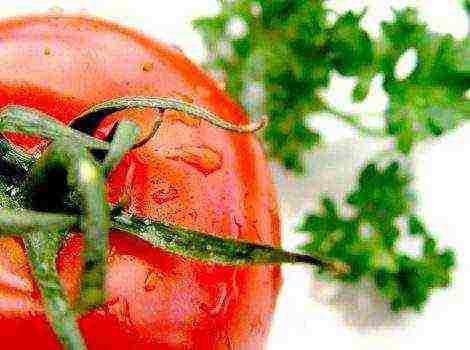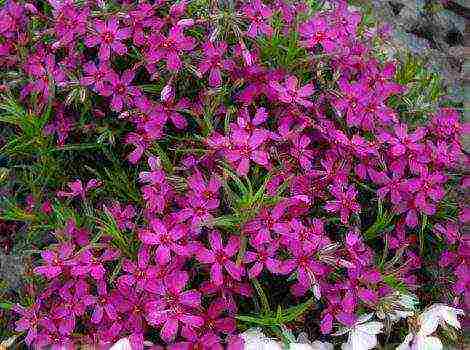Content
- 1 The best varieties of leaf parsley
- 2 The best varieties of root parsley
- 3 Growing parsley
- 4 The best varieties of leaf parsley
- 5 Plant characteristics
- 6 Features of agricultural technology
- 7 Root types of parsley
- 8 Leafy varieties of culture
- 9 Choosing curly parsley
- 10 What varieties can be grown in a greenhouse?
- 11 Open area and closed space: a selection of varieties
- 12 Growing a plant for sale

In order for curly parsley to give fresh greens throughout the season, it is sown at several times. If you cannot allocate a large garden bed for parsley, you can sow varieties with different ripeness periods. Early varieties of parsley will be ready in two months from the moment of sowing, two weeks later, mid-season varieties will turn green, and at the end of summer it will be possible to harvest parsley of late varieties.
The most popular varieties of root parsley
Before choosing the best varieties of parsley for your garden, you should decide for what purposes you are going to grow it. If you need roots for cooking and medicinal concoctions, plant root parsley, or leaf parsley for aromatic, lush greens. Among gardeners, root parsley is more popular, since not only roots can be obtained from it, but also a certain amount of greenery, however, it is worth considering that with frequent foliage breaking, the root part remains small and frail. So choose what is more important to you - tops or roots?

In the early variety type of root parsley, the roots are shortened and rather thick.
The peculiarity of the root parsley is that it forms a conical, thickened or cylindrical root of a light shade. Greens grow a little, compared to leafy varieties, it is less aromatic and more harsh. In the early variety type of root parsley, the roots are shortened and rather thick, best suited for drying, and in the late variety type, they are long (up to 40 cm), well suited for long-term storage.
Video about growing different varieties of parsley
Sugar
After 95-100 days from the time the first plants emerge, the variety is ready for use. In a spreading rosette, there are from 20 to 40 leaves, the root crop grows up to 30 cm long, has a conical, pointed shape and a grayish-white color. Inside, the roots of Sugar Parsley are white, with a light yellow heart. It is widely distributed due to its excellent taste.
Yielding
Mid-season root variety with ripeness up to 130 days from the moment the first greens peeped out. A plant weighing about 100 g forms a semi-spreading rosette with 11-20 leaves and a pointed root crop from 20 cm in length with good taste.
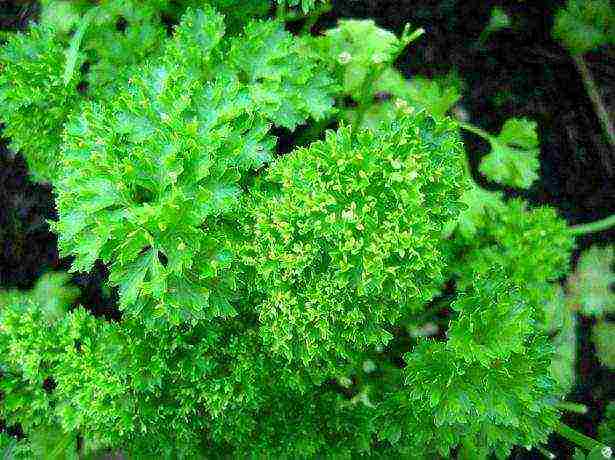
A plant weighing about 100 g forms a semi-spreading rosette
Bordovician
Technical ripeness occurs in about 135 days, as you saw the first shoots. A highly developed rosette consists of 28-30 leaves, the root crop is elongated (about 35 cm), cylindrical, weighing 170 g.
Berlin
A late-ripening variety of root parsley with ripeness from 150 days to 180 days.The plant forms a spreading rosette and a conical root crop with a pointed tip. The diameter of the Berlin parsley root reaches 4 cm, the length is up to 20 cm.
Leaf parsley, the best varieties
The roots of parsley, although edible, look unappetizing, remain thin and harsh. They grow leafy parsley for the sake of greenery. There are two varieties of it: parsley with ordinary leaves and curly parsley, the corrugated leaves of which resemble curls.
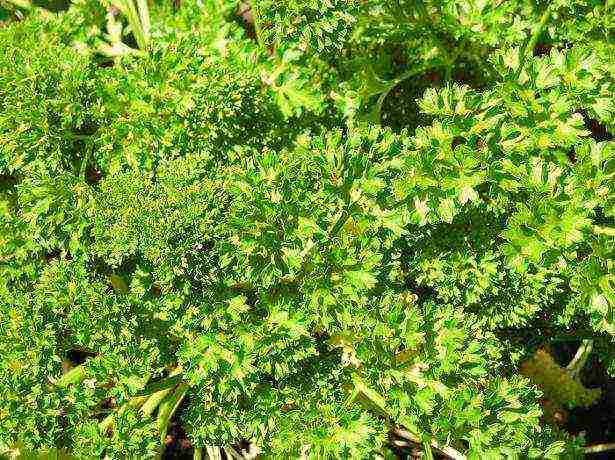
Curly parsley is great for decorating dishes
Curly parsley is excellent for decorating dishes, due to its decorative appearance, and in addition has a pleasant strong aroma and delicate taste. After cutting, the greens grow back very quickly - another crop can be harvested before the end of the season. The cut leaves do not turn yellow for about a week, retaining their taste and persistent aroma.
Aster
An early ripe curly-leaved variety - 65 days after germination, the greens are suitable for eating. The rosette grows dense, half-raised, with large, strongly corrugated leaves. The leaf mass grows actively after cutting.
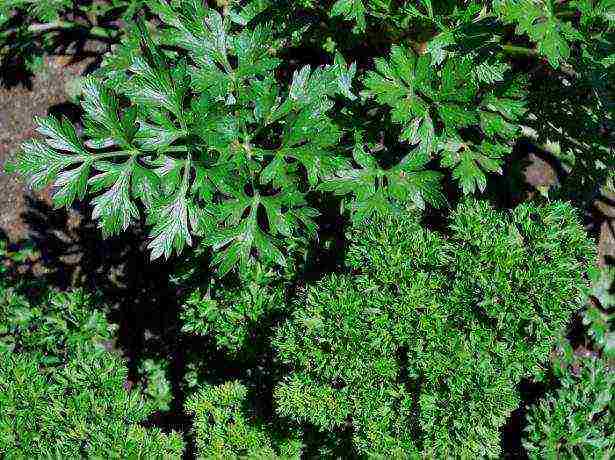
The rosette grows dense, half-raised, with large, strongly corrugated leaves
Ordinary leaf
The variety is prized for its lush, aromatic greenery and high yield. Parsley reaches technical ripeness in 70 days, as the seedlings look. The strongly developed rosette consists of a large number of smooth dark green leaves with a strong dissection. One outlet can contain from 30 to 100 leaves. The roots are not used for food.
Esmeralda
Curly parsley of medium ripeness. The mass of the plant reaches 50 g, about 25-30 leaves with short petioles are formed in the rosette. Grows well after harvest.
Video about the secrets of growing parsley
Breeze
A leafy variety with a ripeness of about 80 days. One plant has a mass of 60 g. The rosette grows up to 75 cm in height, the greens are tender, after cutting, they preserve their freshness for a long time.
The following varieties of leaf parsley are zoned: Bogatyr, Breeze, Astra, Gloria, Magician, Triplex, Sandwich, Titan, Ordinary leaf, Borodinskaya. Curly parsley has zoned varieties: Kucheryavets, Bravo, Mazina, Petra, Curly Leaf.
Rate the article:
(3 votes, average: 3.3 out of 5)
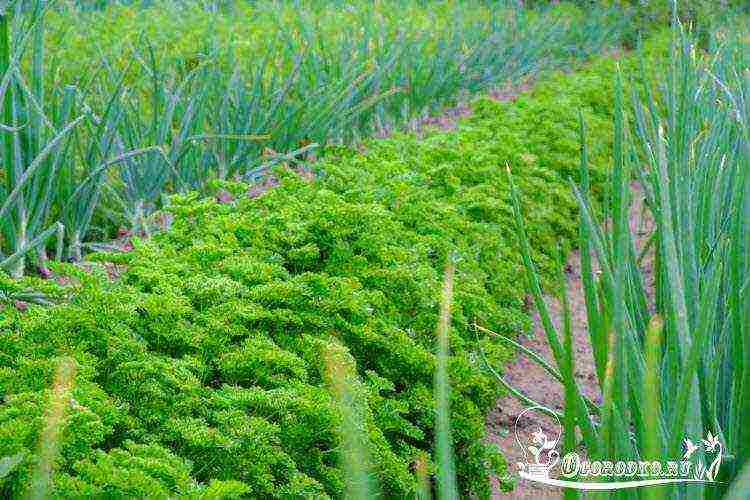
Without exception, everyone loves to eat greens, but what varieties of parsley to choose so that the first vitamins are on the table already with the arrival of spring and do not end until late autumn? From the whole variety of parsley varieties, you can pick up not only early ones, but also tasty, fruitful ones, which can be grown both in a greenhouse and open ground, and on a windowsill in an apartment.
The best varieties of leaf parsley
Leafy parsley for greens is the juiciest and tastiest, with delicate leaves and a wonderful aroma, which is grown for their own needs in small quantities and in large quantities for business for sale. In addition to ordinary parsley, there are curly varieties of greens that are no less tasty and nutritious, can be observed in the form of decorations on dishes.
Parsley Aster belongs to the early varieties, the first young greens are cut off already on the 55-60th day. The rosette of the bushes is dense, the leaves are curly, corrugated, grow remarkably after cutting. The variety is very productive, it is possible to grow on open plantations and closed ground;
 in the photo - a variety of parsley "Astra"
in the photo - a variety of parsley "Astra"
Common parsley refers to the mid-season type, the first greens will be ready by 65-70 days. Leaves are rich dark green color, with a strong aroma. Large rosettes and an abundant amount of strongly dissected leaves indicate a stable high yield.The variety is suitable for reusable cutting;
Parsley Breeze It belongs to high-yielding mid-season varieties, retains its beautiful presentation well after cutting and does not turn yellow for a long time, therefore it is often grown for sale with the aim of making a profit. The leaves are dark and green, shiny, the structure is wavy, but not curly;

parsley variety "Breeze"
Parsley Gloria, another representative of early maturing and fruitful varieties, is cultivated in open ground and greenhouses. The rosette is not high with large leaves. Perfectly transported over long distances and retains keeping quality. Suitable for preparations for the winter and good fresh.
Among the early varieties of parsley, such as curly Babushkina, Kruzhevo, Mooskrause, Nastenka, Russian feast, Madam, Morning freshness, Festivalnaya, Chastushka and others are successfully grown.
 on the photo - growing curly parsley for sale
on the photo - growing curly parsley for sale
A large selection of late and mid-season varieties will not leave without greenery in late summer and autumn. When choosing and buying seeds, pay attention to such varieties of parsley as, Italian Giant, Leaf Bogatyr, Carnival, Katyusha, appetizing, Sandwich, Titan, Rialto, Green crystal.
The best varieties of root parsley
Root parsley is grown for the purpose of obtaining roots, which are used for consumption in their natural form when added to dishes, canning, and drying. Parsley roots are part of various medicinal decoctions and infusions, so it is very important for many to choose a good root variety.
Sugar parsley has an early ripening period, very productive with conical roots, 22-29 centimeters long. The weight of one root is about 30-60 grams, the color of the fruit is white with a grayish tinge. The taste is excellent, therefore it is common among many vegetable growers;
 in the photo - root parsley of the "Sugar parsley" variety
in the photo - root parsley of the "Sugar parsley" variety
Parsley Alba, late-ripening variety. Excellent taste, the mass of one fruit in weight can reach 220-290 grams. It is appreciated for the absence of thin lateral roots, good preservation in winter and decent yield;
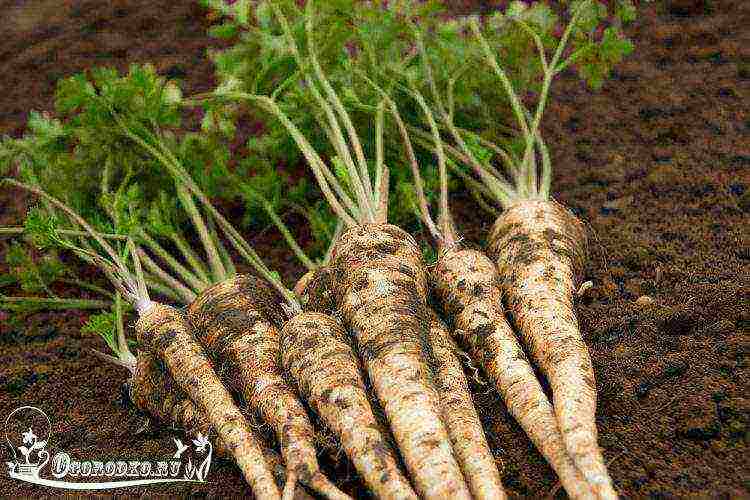 on the photo - root parsley varieties "Alba"
on the photo - root parsley varieties "Alba"
Harvest parsley belongs to the mid-season class, with good tasty conical roots. The length of one root is 18-20 centimeters, the fruits are juicy and white. The variety is resistant to diseases, well stored in winter;
Parsley Final has an average ripening period, the variety is fruitful. The fruits are narrowed, cone-shaped, 21-23 centimeters long, weighing 150-190 grams. The taste of the fruit is excellent, it is used for natural consumption and conservation.
Good root varieties of parsley include such as Vershki and Roots, Good Morning, Eagle, Pikantnaya, Lekar, Konika and many others.
So that fresh parsley is constantly on your table, plant different varieties at time intervals, then tasty and aromatic greens will always be at hand with the onset of spring
Parsley is a biennial herb of the umbrella family. In total, the genus includes two species, but as an indispensable seasoning, both dried and fresh, only curly parsley Petroselinum crispum is grown. Parsley is native to the Mediterranean countries, but has conquered all of Europe, the East, and is common in regions with a temperate climate in North America.
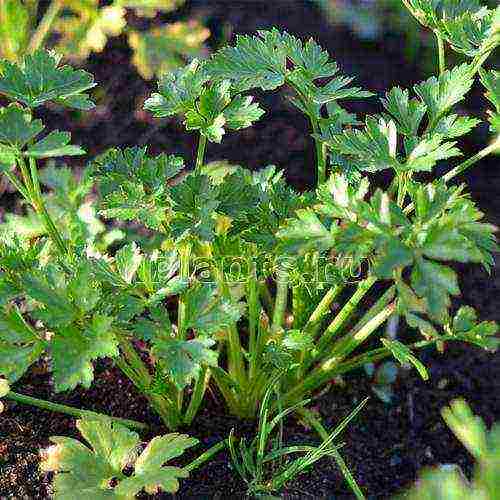
The appearance of this spice is familiar to everyone - erect stems 40-50 cm high, an underground root crop. Twice or thrice-plumose leaves form a rosette of leaves in the first year of sowing parsley.
In the second year, the plant forms long (up to 1 m) peduncles with umbellate inflorescences and small greenish-yellow flowers. Curly parsley leaves are initially simple, with a deeply serrated edge. But there are many varieties on sale, among which there are plants with really curly leaves.
Taste qualities of different varieties - not for everybody.The smell, by the way, is also different - in some it is more pronounced, in others it is weaker. But the beautiful appearance of the leaves of some varieties of curly parsley allows you to grow it not only as a food additive, but also as a beautiful grass in flower beds and flower beds. In addition, parsley is able to scare off some pests from flowers and plants growing in the neighborhood.
Leaves are used as food for curly parsley, less often roots (they are thin, with an uneven bark - you get tired of peeling), in the second year of cultivation, parsley gives a little greenery, but then quickly leaves in inflorescences, therefore it is often grown on a leaf as an annual plant.
It must be said that the species Petroselinum crispum has a variation of Petroselinum crispum var. tuberosum is a root parsley, just a type of leaf. It also has edible leaves, but usually they are denser, sometimes harsh, and their tuber is thick like a carrot and quite smooth. But let's talk about root parsley separately.
Growing parsley
The plant prefers a bright, open area on loose, fertile soil rich in humus. She does not like dense clay soils, shaded places under fruit trees are also not for her - the bushes are formed so frail that from the whole garden once for a salad ...
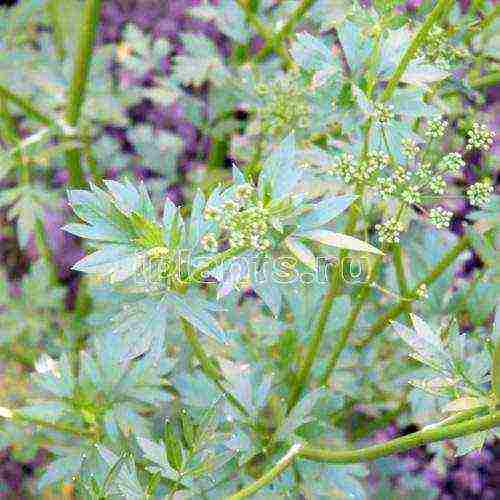
It is advisable to use fresh seeds for sowing, which have been stored for no more than 2 years.
Parsley is remarkable for its cold resistance: it is sown in open ground either in early spring (starting in April) or late in autumn (in October - November). Seeds germinate at 2-3 ° С, and seedlings are able to withstand spring frosts down to -7 ° С. The only difference when sowing in spring and autumn is that in the spring the seeds are soaked for 2 days in a saucer of water with preliminary pickling in potassium permanganate. Dry seeds are sown in autumn!
When sown in autumn, the seeds undergo natural stratification under the snow and sprout amicably in spring. The beds for parsley are not wide, the distance between the rows is 15 cm. The distance between the seeds is 2-3 cm, if the seeds are not very fresh (the seedlings can then be thinned out if necessary).
Fresh seeds are sown in 6-7 cm increments. The planting depth is about 1.5 cm. Sometimes gardeners plant parsley in one row along the edge of flower beds or beds with other herbs and vegetables. Here you need to choose good neighbors.
Parsley grows well next to strawberries and strawberries, cabbage, radishes and radishes, tomatoes, asparagus, and various types of onions. Do not plant parsley next to lettuce and cabbage lettuce, pumpkin, zucchini. You can plant parsley next to carrots, but not after carrots. Planting next to berries is very useful - parsley scares away slugs from strawberries. And parsley planted next to the grape helps protect it from phylloxera.
In addition, parsley is capable of repelling ants and aphids, and it is believed that it contributes to better growth of strawberries. Parsley sprouts within a week, grows quickly enough. The greens are cut off as needed. Caring for parsley is simple - while weeding, thin out the seedlings, if necessary, water, loosen the aisles, at least once every 3-4 weeks.
The best varieties of leafy parsley
Beads are the most wonderful variety - the leaves are extremely delicate (the leaves are very thin, slightly elongated), fragrant and most importantly, it is not just early ripening, it is early ripening parsley! A good bunch can be harvested in 45-50 days (before market ripeness - for those who grow bunches for sale, and do not pick a leaf for soup - 60 days.)
- Of the early varieties (60-65 days before cutting) are good: Astra, Madame, Gloria, curly Mooskrause.
- From mid-season (80 days before cutting): varieties Breeze, Sandwich, Ordinary leaf, curly Esmeralda.
- From the late ripening (more than 80 days before the mass collection of leaves) - the Bogatyr variety.
The parsley variety Bogatyr, in addition to good leaf mass, is shade-tolerant. Also well suited for winter forcing in boxes or pots on the windowsill (greenery for the New Year).In a number of varieties, the root is completely inedible (for example, in Mooskrause and Ordinary leafy). Some varieties form an edible conical tuber, which is quite large. Others have no root crop.
Similar posts
The spice for flavoring soups, salads and stews can be grown in a country allotment. When choosing varieties of healthy parsley, consider their type - root or leaf. The biennial is also divided into early (leaves are formed after 60 days), mid-season (turn green after 75 days) and late (harvested at the end of summer) varieties.
Plant characteristics
In the Russian space, it is important to grow root or leaf varieties. Parsley attracts with aromatic properties, the ability to improve the taste of dishes. The biological description of a representative of the Umbrella family is reduced to the following indicators:
- the presence of a fleshy root about 30 cm long;
- branching of erect stems;
- glossy structure of the upper part of the leaves and a matte surface at the lower;
- a soft yellowish root vegetable in root varieties, which is consumed in dried form;
- tolerance to lower temperatures - seedlings do not die under the snow.
Isolating a good kind of culture is problematic. Among the leafy ones, common parsley attracts with a pronounced aroma, and curly - a beautiful form of foliage, thanks to which it is used to decorate dishes. 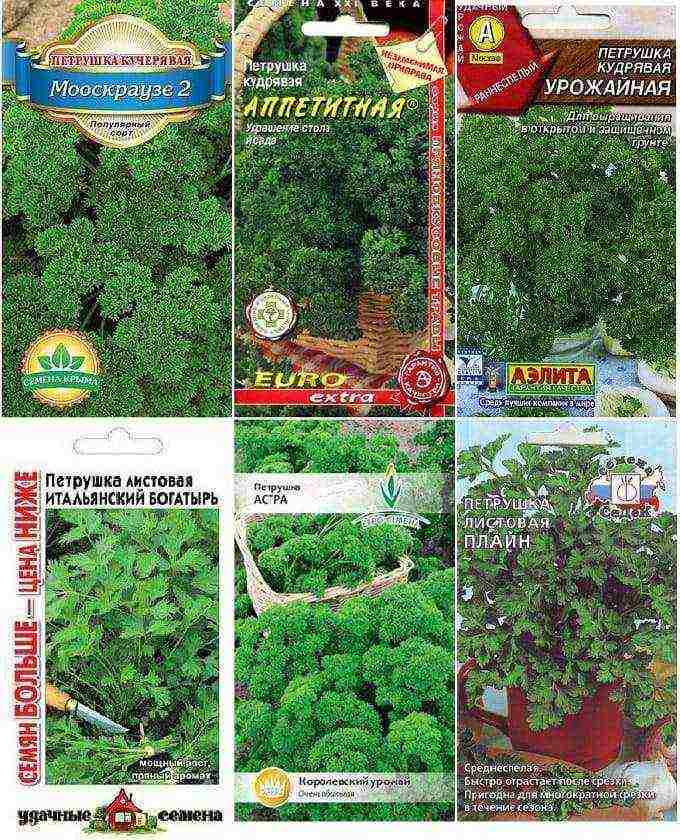
Features of agricultural technology
The course of work depends on the climatic conditions of the area, but they are of a similar nature. The soil is necessarily loosened or dug up, processed with organic matter. Cold-resistant umbrella is recommended to be planted at temperatures from +1 to +5 degrees. On the territory of the Kuban, vegetable gardens are sown with parsley in February, and in the middle lane - from April. The soil needs to be moistened periodically. Onions, cucumbers and tomatoes are good precursors for the plant.
The landing and leaving activities are as follows:
- shallow sowing of seeds (the depth of the holes is not more than 1.5 cm);
- mandatory dusting of the planted material with compost;
- periodic loosening of the soil (3-4 times every 7 days), the introduction of 1-2 mineral (preferably nitrogen) dressings;
- thinning seedlings to a distance between them equal to 3-5 cm;
- regular watering - parsley does not tolerate drying out of the soil.
It is required to cut the leaves of the grown culture low, not in excess. Removing a lot of foliage at one time will kill the stem. You can plant tomatoes, asparagus or a rose bush next to the umbrella.
When choosing the best varieties of parsley for your garden, be guided by your growing goals. Tasty roots are suitable for preparing culinary dishes and medicinal concoctions. Leafy species are added to salads, used for sale. 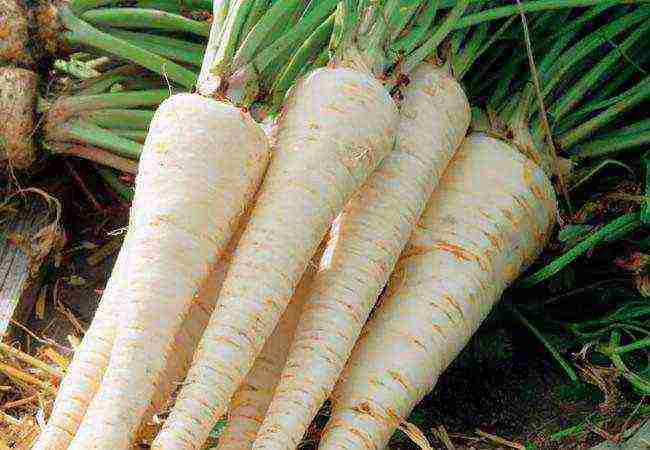
Root types of parsley
The plant is successfully cultivated in the middle lane, warm regions and in the Urals. The main characteristic of the variety is a thick root in the form of a cone or cylinder. It practically does not form green leaves, and the type of root crop depends on the cultivar. The early ones have short and thick fruits that are dried. Late varieties with roots up to 40 cm long tolerate long-term storage well.
Delicious variety Sugar
It ripens in 95-100 days after disembarkation. The rosette is spreading, there are 20-40 sheets on it. The length of the conical, pointed root vegetable reaches 30 cm. The root is colored grayish-white, has a light yellow core and a sweetish taste. 
Mid-season Yielding
The root variety of parsley reaches ripeness 130 days after the seeds are sown. The root weighing 100 g is characterized by a pointed shape. The rosette spreads out in half and forms about 20 sheets.
Bordovic - ideal for soups
The time of technical ripeness is 135 days after the emergence of shoots. The rosette is well developed - up to 30 leaves are formed. The root vegetable is characterized by an elongation, a cylinder shape and a weight of about 170 g.
Late Berlin
The plant belongs to species with late maturity - from 150 to 180 days. The rosette is spreading, the cone-shaped root crop has a pointed end. The root reaches a length of about 20 cm.
Root varieties of the plant are used as a seasoning for soups, stews or fried dishes, rarely used for salads. 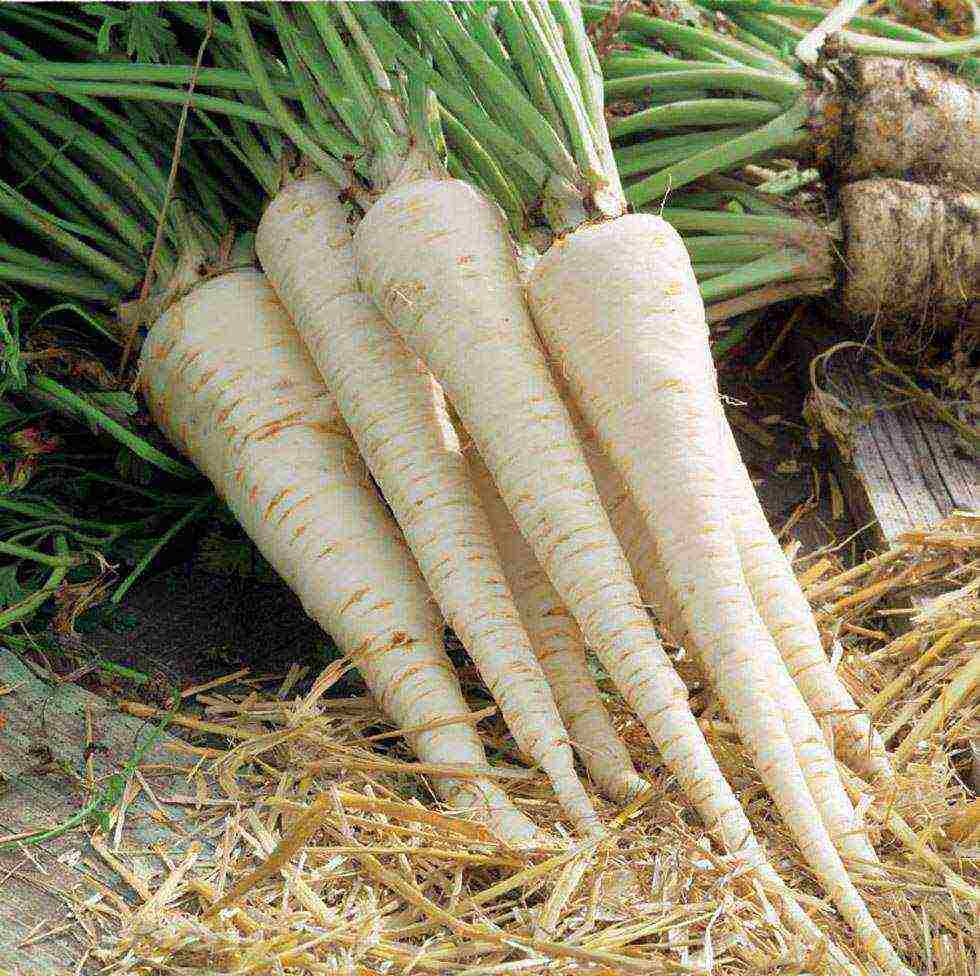
Leafy varieties of culture
Leafy varieties of parsley are ideal for greens - the foliage is abundant, the stems grow very quickly. Pleasant taste and bright aroma of smooth leaves in a small corrugation conquer cooks and summer residents.
Yielding Common
The species is valuable for fragrant herbs and good yield. An early variety becomes ripe 70 days after germination. The rosette is developed, characterized by the presence of up to 100 dark green leaves. The root crop is not eaten.
Mid-season Breeze
Parsley reaches technological maturity after 80 days. The rosette is high, about 70 cm. Green leaves are distinguished by their delicate taste and the ability to maintain freshness during long-term storage. 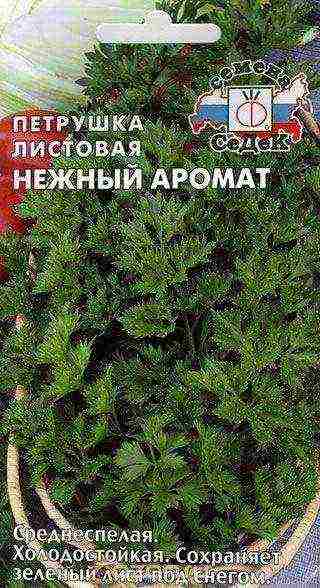
Late maturing green crystal
The universal variety is distinguished by the intensity of the formation of green leaves with a bright aroma. Shoots cut from a raised rosette are distinguished by a fast growth rate. A large green mass is frozen, used fresh, dried, or canned.
Early ripe Delicate aroma
Parsley has shiny, bright green leaves with excellent decorative properties. The leaves grow back quickly after cutting, and can be used as a decoration for food.
Beautiful Festival
The technological readiness of the leaves for consumption occurs in 55-60 days. The developed rosette forms up to 60 dark green, strongly dissected leaves. Due to the content of essential oils, the culture has a rich aroma. For salads, shoots are used that have grown by 10-12 cm; you can dry the green mass during the period of bud formation.
Leafy crops are relevant as a seasoning for soups, side dishes or fish dishes. 
Choosing curly parsley
The plant's priorities are in its decorative ability and unpretentiousness. You can plant an umbrella in greenhouses, in the beds, because it is drought-resistant thanks to the corrugation of the sheets. The bright aroma of roots and foliage remains after heat treatment, so they can be used as a seasoning, sauces and purees, and dried. The fresh plant has an extraordinary taste, which makes it indispensable as an ingredient in spring salads. Several varieties take root well in the domestic climate.
Compact Slavic
Stems of medium length conquer with a pronounced aroma. Parsley tolerates cold snaps and dry weather well.
Early ripe Aster
The greens are ready for use already 65 days after the formation of shoots. On a dense, slightly raised rosette, leaves with a pronounced corrugation are formed, which, after cutting, quickly grow back. 
Mid-season Esmeralda
The plant weighing 50 g belongs to the varieties of medium ripeness. On rosettes - about 30 leaves on short cuttings. They grow vigorously even after being cut.
Universal Mooskrause-2
It takes only 60 days from germination to full technical maturity. On a semi-spreading rosette, light green leaves with a shiny surface appear. Sweetish corrugated greens are a fragrant seasoning for soups, side dishes and salads. Parsley is grown in greenhouses and in open areas. Cut shoots grow quickly.
You can plant seeds of curly varieties in the beds where cabbage, pumpkin, tomatoes, eggplants grew. The site is prepared twice - in the fall it is loosened with the introduction of humus or compost. In the spring, loosening is repeated, but mineral additives are already introduced. 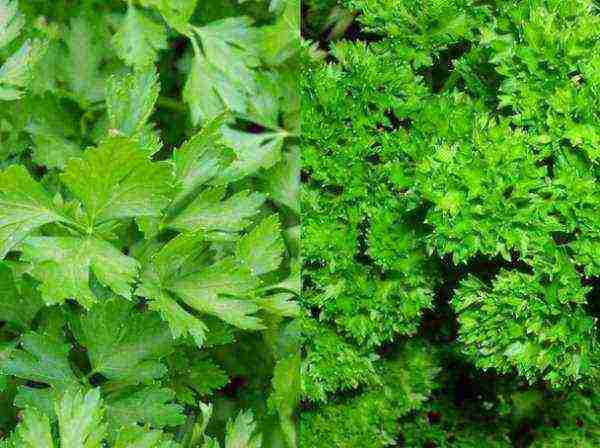
What varieties can be grown in a greenhouse?
To get tasty, healthy and fragrant greens, it is advisable to plant the plant in a greenhouse.Leaves form quickly from January to April at temperatures from +20 to +25 degrees. Good yield in greenhouse conditions in the following species:
- Lyubasha. The plant is distinguished by a semi-vertical rosette and the presence of elongated triangular leaves on long cuttings. The mass of the root is about 100 g. For foliage and root crops, a rich, dense aroma is characteristic;
- Gloria. Mid-season leaf culture is used for freezing, soups, salads;
- Alba. A mid-season root variety, which is distinguished by a large root weighing up to 300 g. A tasty root vegetable is valuable due to the absence of small lateral shoots, good keeping quality and yield;
- Spicy. The root variety is early ripening, forms a small rosette of 20 leaves. Taste qualities of the root are suitable for cooking, eating dried.
In greenhouses, it is best to grow root crop types that can be stored for a long time. The cultivation of leafy varieties is relevant only if they are further sold. 
Open area and closed space: a selection of varieties
Umbrella plants germinate not only in greenhouses, but also in open areas and even on a windowsill. The main condition for work is the choice of a suitable variety.
Parsley at their summer cottage
For open ground, root and leaf varieties are justified. Root varieties may have different ripening periods, but it is better to stop at Finale, Lekar, Needle, Piquant. Root crops with high yields have a pleasant color, worthy indicators of taste and aroma.
In the line of leafy plants, Madame, Breeze, Gloria, Esmeralda and Mooskrause are relevant. Before planting, you need to process the seeds using hot, but not boiled water.
Soil preparation rules
Before moving the material to the site, soil preparation is required:
- a place is chosen for a garden with good lighting;
- the allotment is fertilized with ash (about 170 g of fertilizer is required per 1 m2);
- on the planting site, grooves are cut, deepened by 1.5 cm with row spacing equal to 20 cm;
- seeds are sown at the rate of 1 g per 1 m2, covered with soil.
The last stage of work is compaction of the earth, watering, covering with foil and mulching. 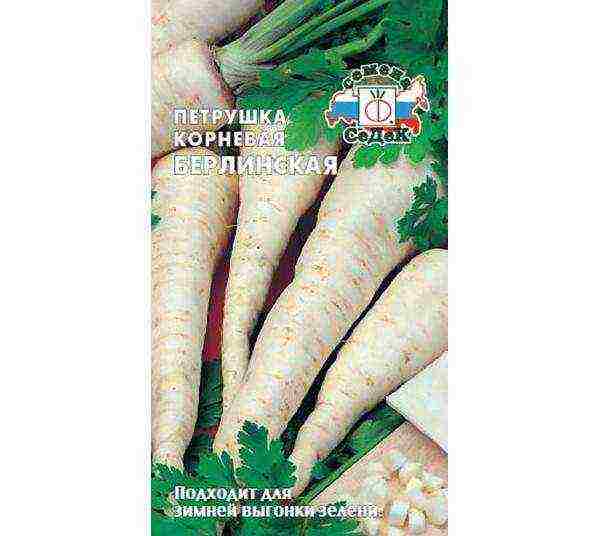
Parsley on the windowsill: how to grow?
To pamper yourself with healthy greens all year round, they stop at early-maturing varieties - Aromatnaya Alley, Green Pearls, Russian Feast, Vorozheya, Astra. Plant rosettes are vertical and semi-vertical. Curly and leafy species are ready to eat in 50-60 days and are characterized by large leaf sizes, aroma and rapid growth after cutting.
Planting parsley on the windowsill is performed using the following technology:
- The seeds are prepared by soaking in water for 48 hours. The water needs to be changed 2 times a day. Before sowing, the grains are placed in a weak solution of potassium permanganate.
- Several holes are made in the deep drawer. The container is filled with soil, spilled with hot water. The soil needs to be slightly compacted.
- Furrows are formed in the ground, deepened by 0.5 cm.
- Seeds are sown in the ground, covered with earth. To preserve the looseness of the soil, sprinkle it on 1 cm of dry soil.
- Crops need to be moistened with a spray bottle and the temperature should be maintained at about +20 degrees. To create good lighting, phytolamps are installed at a distance of 50 cm from the box.
Frequent seedlings need to be thinned out. 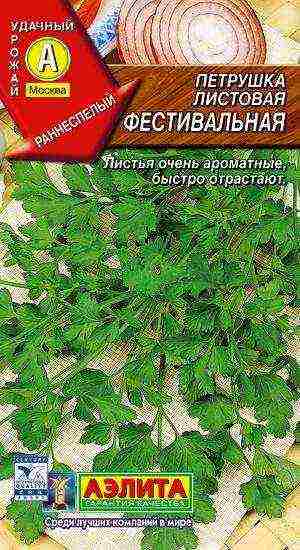
Varieties suitable for the Moscow region
The unpretentiousness and productivity of parsley makes it a popular crop in the central regions of Russia. The Moscow region is known for its temperate continental climate, where the following varieties successfully take root:
- Bogatyr. A universal variety, since germinates well in greenhouses and in open areas. The growing season is 60-65 days. A sufficient number of fragrant and juicy leaves are formed on a large outlet.The root and foliage are used for food, but the greens on the plants from which the root crop is used are not cut off;
- Hamburg. A hybrid species whose root vegetable tastes like celery and parsnips. The roots are stored for a long time; when cooking in deep fat, they are sprinkled with lemon juice;
- parsley The Italian giant attracts attention with its beautiful leaves with a smooth surface. The mass of large, delicate greens of a dark green hue reaches 100 g per bush. The biennial plant is a mid-season plant - harvesting begins after 90 days;
- Carnival. The growing season of the early ripening variety is up to 75 days. A large outlet contains up to 100 succulent leaves. The culture tolerates cold, is resistant to fungi, is sown in spring and autumn, germinates for the winter in containers with a special soil mixture.
All varieties of the umbrella plant are photophilous, but take root in a small shade. In the conditions of the Moscow region, minimal care is required - periodic loosening of the soil, watering and feeding. The leaf mass is cut at a height of 10-12 cm. 
Growing a plant for sale
Summer residents and gardeners can cultivate parsley for the purpose of sale. To get beautiful, lush and fragrant leaves, you need to take into account the presence of a shell on the seeds with essential components that slow down growth. There are several ways to get rid of the seeds from the shell:
- having doused with hot water (about +22 degrees) and flooding them. The water should be changed up to 6 times a day for 72 hours. Before planting, the material is soaked in a mixture of water, minerals and growth stimulants.
- soaking in vodka. Gauze is placed on a plate, seeds are placed on it and poured with alcohol. After 15 minutes, the material is washed with water.
- Liming the soil. Slaked lime is poured into a box with moistened earth in 3 sets of 15 minutes each. Sow the material soaked in milk.
When growing parsley, it is important to observe a temperature regime of at least +20 degrees.
Vitamin culture is a promising form of income, since not all owners can grow greens on a large scale.
The taste properties of the roots and leaves of parsley have earned the trust of culinary experts. Leafy and root varieties can be used as a seasoning for soups and salads, added to sauces and marinades, baked and canned.

